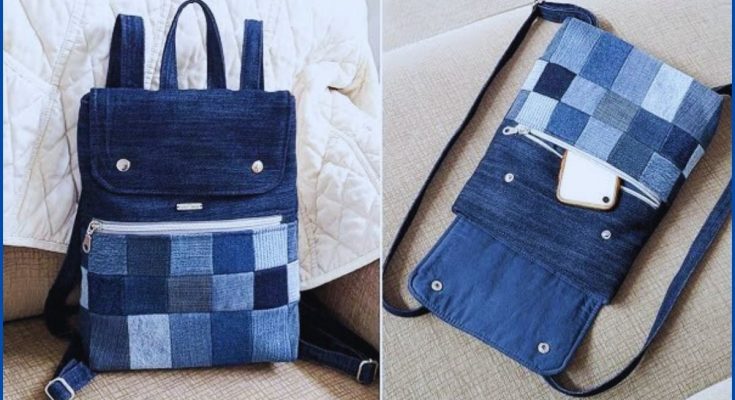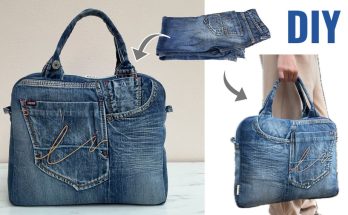What a fantastic idea! Turning old jeans into a DIY denim backpack with a patchwork pocket is a superb way to create a sturdy, unique, and eco-friendly accessory. Denim’s natural durability makes it perfect for a backpack that will stand up to daily use, and the patchwork pocket adds a delightful touch of personalized style.
This detailed tutorial will guide you through crafting a functional and stylish backpack, complete with a main compartment, a fun patchwork front pocket, a top flap, and adjustable straps.
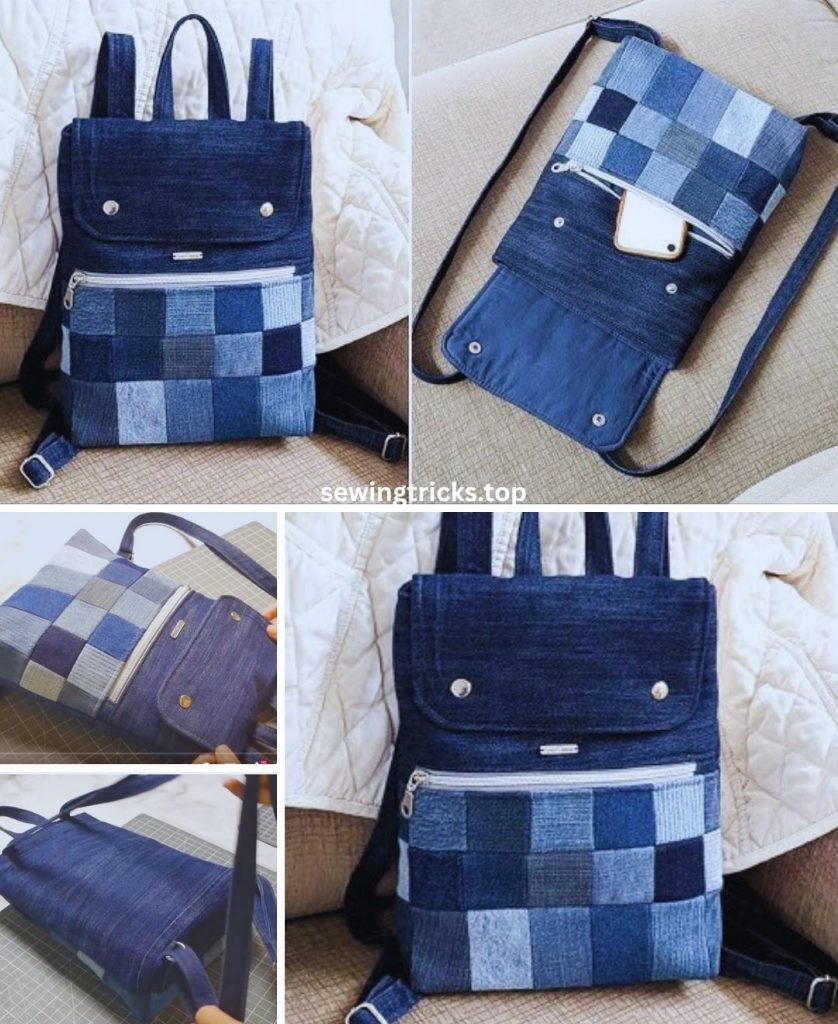
How to Sew a DIY Denim Backpack with a Patchwork Pocket from Old Jeans
I. Planning Your Upcycled Denim Backpack
Careful planning is crucial for a project like a backpack, especially when working with repurposed materials. It helps you maximize your denim and ensures a successful outcome.
- Assess Your Denim Supply:
- You’ll need a good amount of denim for a backpack. At least 1-2 pairs of adult jeans (men’s larger sizes or women’s plus sizes) are recommended. More if you want extensive patchwork or a very large backpack.
- Non-stretch or low-stretch denim is ideal. High-stretch denim can be tricky to work with for structured items.
- Ensure jeans are clean, ironed, and free of major flaws (unless you want to incorporate them as design features). Varying denim washes (light, medium, dark) will be great for the patchwork pocket.
- Desired Backpack Size: Think about what you’ll carry.
- A versatile medium-sized backpack might be around 12 inches wide x 14 inches tall x 4 inches deep (30.5 cm x 35.5 cm x 10 cm) when finished. This size is good for a day trip, carrying books, or everyday essentials.
- Design Elements:
- Main Body: Will be constructed from larger denim panels (pieced if necessary).
- Patchwork Pocket: The star! This will be a smaller panel of pieced denim scraps.
- Lining: Highly recommended! A lining gives your backpack a professional finish, hides raw seams, and adds durability. You’ll likely use a new, complementary fabric for this.
- Stabilizer/Interfacing:Essential! This is what gives your backpack structure and prevents it from being saggy.
- Heavyweight Fusible Interfacing (e.g., Pellon 809 Decor Bond or Pellon 71F Peltex II Ultra Firm): Best for a sturdy, structured backpack.
- Closure: For the main compartment, a simple drawstring closure with a flap is classic and relatively easy. You could also add a magnetic snap to the flap.
- Straps: Adjustable shoulder straps are a must. These can be made from denim, webbing, or a combination. We’ll make them from denim and use hardware for adjustability.
- Hardware (Important!):
- For Adjustable Straps: You’ll need two rectangular slider buckles (often called ladder lock buckles) and two rectangular rings (or D-rings), sized to match your strap width (e.g., 1-inch or 1.5-inch/2.5 cm or 3.8 cm).
II. Gather Your Materials
Having everything ready before you start sewing will make your project much smoother.
- Old Jeans: 1-2 pairs of clean, ironed, sturdy denim jeans.
- Lining Fabric: 1 yard (0.9 meters) of medium-weight quilting cotton, broadcloth, or poly-cotton. Choose a fun print or color.
- Heavyweight Fusible Interfacing: 1.5 yards (1.4 meters) (e.g., Pellon 809 Decor Bond or Pellon 71F Peltex II Ultra Firm).
- Hardware for Straps:
- 2 Rectangular Slider Buckles: (e.g., 1-inch or 1.5-inch / 2.5 cm or 3.8 cm).
- 2 Rectangular Rings (or D-rings): (same width as your buckles).
- Drawstring Cord: Approximately 2 yards (1.8 meters) of sturdy cord or rope (e.g., paracord, cotton cording, or even a shoelace).
- Optional Magnetic Snap: 1 set, about 1/2-inch (1.27 cm) or 3/4-inch (1.9 cm) diameter, for the flap.
- Matching Thread: Strong, all-purpose polyester thread. For topstitching on denim, use a slightly thicker topstitching thread in a contrasting color (like gold, orange, or beige).
- Basic Sewing Supplies:
- Sewing Machine: With a walking foot (highly recommended!) and standard presser foot.
- Heavy-Duty Needles: Denim needles (size 90/14 or 100/16) are essential. Have spares!
- Sharp Fabric Scissors or Rotary Cutter and Mat.
- Long Quilting Ruler or Measuring Tape.
- Fabric Chalk or Mark-B-Gone Pen.
- Plenty of Wonder Clips (superior to pins for thick denim and multiple layers).
- Iron and Ironing Board (crucial for pressing seams flat and fusing interfacing).
- Seam Ripper (your best friend for deconstructing jeans and correcting mistakes!).
- Safety Pin or Bodkin: For threading the drawstring.
- Awl (Optional): For marking holes for magnetic snap prongs.
III. Prepare Your Jeans & Cut Fabric Pieces
Accuracy in cutting and piecing is key for a well-structured backpack. We’ll use a consistent 1/2-inch (1.27 cm) seam allowance throughout this tutorial, unless otherwise specified for patchwork.
- Desired Finished Backpack Size: 12″ W x 14″ H x 4″ D (30.5 cm x 35.5 cm x 10 cm).
A. Deconstruct Your Jeans:
- Cut Off Legs: Lay jeans flat, cut just below the crotch seam.
- Open Leg Seams: Use your seam ripper to open both the inseam and outseam of each leg to get large, flat panels. Iron these flat.
- Salvage Pockets/Waistband (Optional): Carefully remove back pockets, belt loops, or waistband pieces if you plan to use them as accents.
B. Cut Your Fabric Pieces:
- Exterior Denim Pieces:
- Main Body (Front & Back): Cut 2 rectangles, each 17 inches wide x 19 inches high. (This accounts for 12″ finished width + 4″ finished depth + 1″ seam allowance on sides. For height: 14″ H + 4″ D + 1″ SA = 19″ H).
- Important on Piecing: You will very likely need to piece together sections of your opened jean legs to get these large panels.
- How to Piece Denim: Place two denim pieces right sides together, aligning a raw edge. Stitch with a 1/2-inch seam allowance. Press the seam open thoroughly. Topstitch (Highly Recommended!): On the right side, sew two parallel lines, 1/8″ from the seam, using topstitching thread.
- Bottom Piece: Cut 1 rectangle, 17 inches wide x 5 inches high.
- Strap Pieces: Cut 2 rectangles, each 4 inches wide x 30 inches long. (Adjust length as desired for shoulder vs. cross-body wear). You may need to piece these.
- Strap Tabs (for hardware): Cut 2 rectangles, each 2 inches wide x 4 inches high.
- Flap: Cut 1 piece, 10 inches wide x 9 inches high. (You can curve the bottom corners later).
- Drawstring Casing/Facing: Cut 1 rectangle, 17 inches wide x 8 inches high.
- Patchwork Pocket Pieces: Cut several small squares and rectangles from varying denim washes. Aim for pieces that are at least 1 inch larger than your desired finished patch size to account for seam allowances (e.g., for a 3″ finished square, cut 4″ x 4″). You’ll need enough to piece a panel that is 10 inches wide x 9 inches high (finished pocket size, including seam allowance).
- Main Body (Front & Back): Cut 2 rectangles, each 17 inches wide x 19 inches high. (This accounts for 12″ finished width + 4″ finished depth + 1″ seam allowance on sides. For height: 14″ H + 4″ D + 1″ SA = 19″ H).
- Lining Fabric Pieces:
- Main Body (Front & Back): Cut 2 rectangles, each 17 inches wide x 19 inches high.
- Bottom Piece: Cut 1 rectangle, 17 inches wide x 5 inches high.
- Flap: Cut 1 piece, 10 inches wide x 9 inches high.
- Drawstring Casing/Facing: Cut 1 rectangle, 17 inches wide x 8 inches high.
- Interior Slip Pocket (Optional): Cut 1 rectangle, 8 inches wide x 10 inches high.
- Heavyweight Fusible Interfacing:
- Main Body (Front & Back): Cut 2 rectangles, each 16 inches wide x 18 inches high (1 inch smaller on all sides).
- Bottom Piece: Cut 1 rectangle, 16 inches wide x 4 inches high.
- Strap Pieces: Cut 2 rectangles, each 3 inches wide x 29 inches long.
- Strap Tabs: Cut 2 rectangles, each 1.5 inches wide x 3 inches high.
- Flap: Cut 1 piece, 9 inches wide x 8 inches high.
- Drawstring Casing/Facing: Cut 1 rectangle, 16 inches wide x 7 inches high.
- Patchwork Pocket Backing: Cut 1 rectangle, 9 inches wide x 8 inches high.
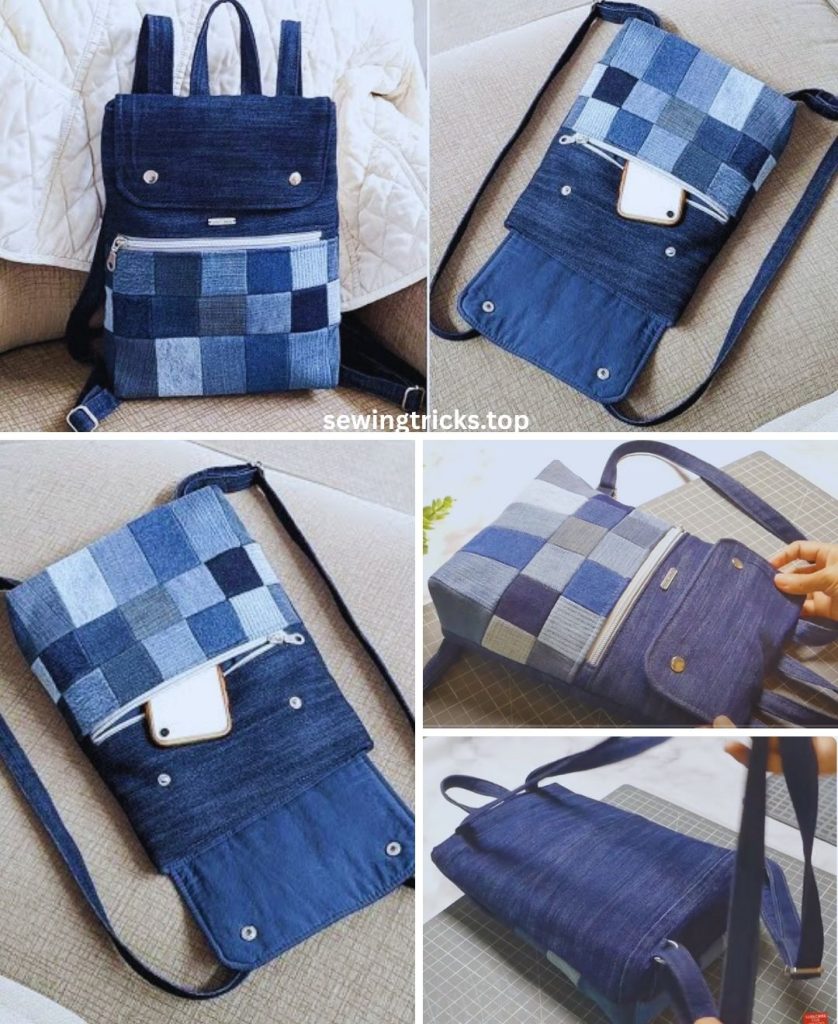
IV. Let’s Start Sewing Your Denim Backpack!
General Sewing Tips for Denim & Heavy Fabrics:
- Pressing is CRITICAL! Press seams after every stitching step to reduce bulk and create crisp, professional results. Use a good, hot iron.
- Backstitch at the beginning and end of every seam.
- Use your walking foot. This is paramount for feeding thick fabric layers evenly and preventing puckering.
- Wonder Clips are your best friends here. They hold thick layers much better than pins.
- Go Slow! Stitch slowly, especially over thick seams, intersections, or multiple layers of denim and interfacing. Gently hand-crank your machine over particularly bulky spots if needed.
- Topstitching: Use a slightly longer stitch length (3.0-3.5mm) for all topstitching to get that authentic denim look. Use topstitching thread if desired.
Step 1: Fuse Interfacing
- Lay all exterior denim pieces and all interfacing pieces wrong side up on your ironing board.
- Center the corresponding interfacing piece on each denim piece (it should be 1 inch smaller on all sides).
- Following the manufacturer’s instructions for your specific interfacing, fuse the interfacing to the wrong side of the fabric. Press firmly and allow to cool completely. This gives your backpack its essential structure.
Step 2: Assemble the Patchwork Pocket
- Arrange Patches: Lay out your cut denim scraps for the pocket on a flat surface. Aim to create a rectangle that will finish at approximately 10 inches wide x 9 inches high. Take a photo of your layout for reference.
- Piece Patches:
- Place two adjacent patches right sides together, aligning an edge. Stitch them together using a 1/4-inch (0.6 cm) seam allowance.
- Press the seam open (or to one side).
- Continue adding patches, stitching them together one by one, then joining rows/columns until you have one large patchwork piece.
- Topstitch (Optional): After pressing each seam, you can topstitch along both sides of the seam (on the right side of the fabric) to mimic jean seams.
- Fuse Patchwork to Backing: Once your patchwork is complete, fuse it to the patchwork pocket backing interfacing (9″ x 8″ piece) on the wrong side.
- Trim Pocket: Trim your completed patchwork panel to 10 inches wide x 9 inches high. This is your Exterior Patchwork Pocket.
Step 3: Attach Patchwork Pocket to Front Main Panel
- Take one of your Exterior Denim Main Body Panels (17″ W x 19″ H). This will be the front of your backpack.
- Find the center of this panel. Position your Exterior Patchwork Pocket centered horizontally on the lower half of the front panel. A good placement is with the bottom edge of the pocket about 3-4 inches (7.6-10 cm) up from the bottom raw edge of the main panel.
- Topstitch the pocket onto the main panel along its two sides and bottom edge, close to the folded edges. Leave the top edge of the pocket open.
- Reinforce: At the top corners of the pocket opening, sew a small triangle or an extra back-and-forth stitch for durability, as this area will see stress.
Step 4: Prepare and Attach Backpack Straps
- Prepare Straps (2 pieces, 4″ x 30″ denim):
- Fold each strap in half lengthwise, wrong sides together, and press firmly. Open it up.
- Fold each long raw edge in towards the center crease, and press again.
- Fold the entire strip in half again along the original center crease. You should now have a long, flat strap that is about 1 inch (2.5 cm) wide with no raw edges visible. Press firmly.
- Topstitch down both long sides of each prepared strap, about 1/8 inch (0.3 cm) from the edge. This secures all the folds and makes a neat, strong strap.
- Prepare Strap Tabs (2 pieces, 2″ x 4″ denim):
- Fold each tab lengthwise, press. Fold raw edges to center, press. Fold in half. Topstitch along both long sides.
- Thread a rectangular ring (or D-ring) onto each tab. Fold the tab in half to create a loop, enclosing the ring. Set aside.
- Attach Straps to Backpack Back Panel:
- Take your remaining Exterior Denim Main Body Panel (17″ W x 19″ H). This will be the back of your backpack.
- Measure in from each top corner by about 3-4 inches (7.6-10 cm) along the top raw edge. Mark these points.
- Position the raw ends of one prepared strap on the back panel at your marks, making sure the strap itself is flat and not twisted. The strap should point downwards into the bag.
- Stitch the strap ends in place using an X-box stitch (sew a square, then an “X” through it) for maximum reinforcement. Stitch within the 1/2-inch (1.27 cm) seam allowance, close to the raw edge. Repeat for the second strap.
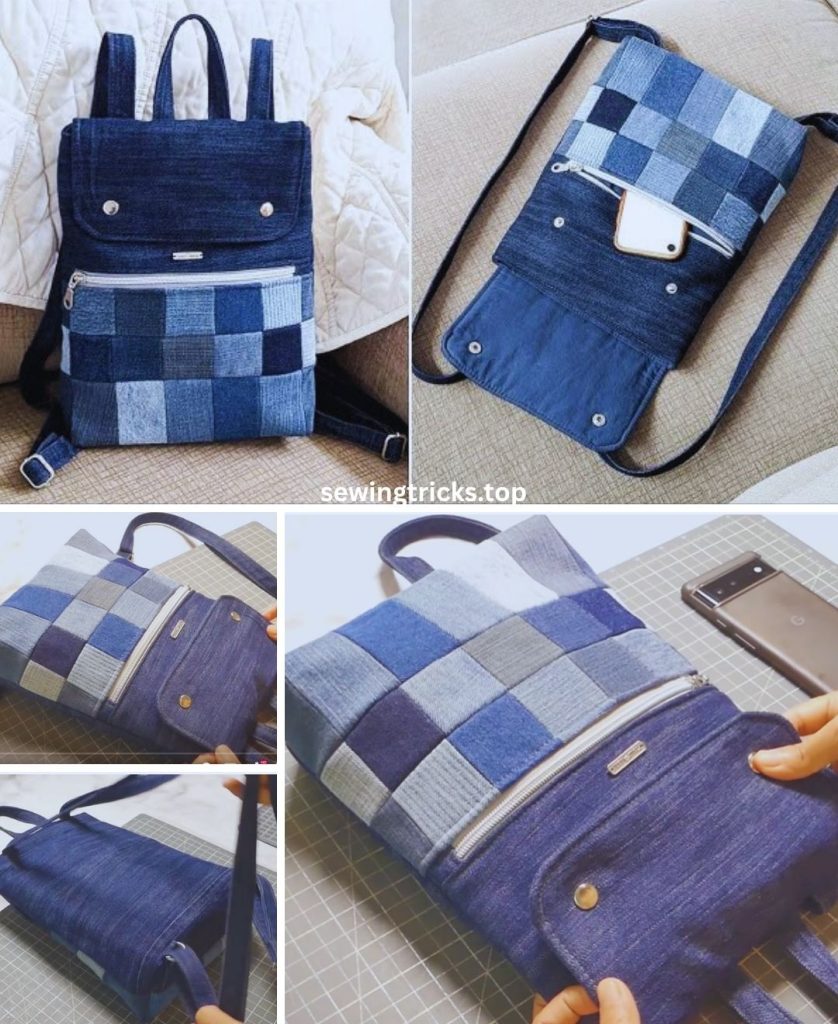
Step 5: Construct Exterior Bag Body
Use a 1/2-inch (1.27 cm) seam allowance.
- Place the Exterior Front Main Body Panel (with pocket) and the Exterior Back Main Body Panel (with straps) right sides together, carefully aligning side edges. The straps should be tucked inside.
- Clip securely along both side edges.
- Stitch down both side edges. Press seams open.
- Attach Exterior Bottom Piece:
- Take your Exterior Denim Bottom Piece (17″ W x 5″ H).
- Align one long 17-inch edge of the bottom piece with the bottom raw edge of your main backpack body, right sides together. Stitch. Press seam open.
- Align the other long 17-inch edge of the bottom piece with the remaining raw edge of the main backpack body (this will bring the sides of the bottom piece up to meet the bottom of the main body), right sides together. Stitch. Press seam open.
- This forms a “tube” with an open bottom and open top.
- Box the Corners (Bottom):
- Lay the backpack body flat with the bottom piece sewn in. The side seams of the main body should now align with the short 5-inch seams of the bottom piece.
- At each bottom corner, you’ll see a small triangle forming where the side seam meets the bottom piece seam. Pinch this corner so the side seam and the bottom seam meet perfectly.
- Measure from the tip of this triangle inward along the seam line a distance equal to half of your desired bag depth (e.g., for a 4-inch deep bag, you’ll measure 2 inches / 5 cm).
- Draw a straight line perpendicular to the seam at this measured point (this line will be 4 inches long if your desired depth is 4 inches).
- Clip firmly along this drawn line. Stitch precisely along the drawn line, backstitching securely.
- Trim the excess fabric from the corner, leaving about a 1/2-inch (1.27 cm) seam allowance.
- Result: Your exterior backpack body is now fully formed with a flat bottom. Keep it wrong side out.
Step 6: Construct Lining Bag Body (with Optional Pocket)
The lining is constructed almost identically to the exterior bag, with one crucial difference for turning the bag right side out.
- Prepare Interior Slip Pocket (Optional):
- Take your 8″ x 10″ pocket piece (lining fabric). Fold it in half, right sides together, so it’s 8″ x 5″. Stitch around three sides (two long, one short), leaving a 3-4 inch (7.6-10.2 cm) opening on the remaining short side (bottom of pocket). Trim corners.
- Turn right side out, push out corners, and press flat. Stitch opening closed.
- Position and topstitch pocket to one Lining Main Body Panel.
- Sew Lining Body:
- Place the two Lining Main Body Panels right sides together. Stitch side seams. Press open.
- Attach the Lining Bottom Piece using the same method as the exterior (Step 5.4). Press seams open.
- Box the Corners: Box the bottom corners of your lining bag using the exact same method you used for the exterior bag (Step 5.5).
- CRUCIAL STEP: Leave a Turning Opening! In the bottom seam of the lining bottom piece, leave a 4-6 inch (10-15 cm) unstitched gap. This opening is absolutely essential for turning the entire backpack right side out later. Backstitch well at the start and end of the stitched sections around your opening.
- Result: Your lining bag is now formed. Keep it wrong side out.
Step 7: Prepare Drawstring Casing/Facing
- Take your Exterior Drawstring Casing/Facing (17″ W x 8″ H) and Lining Drawstring Casing/Facing (17″ W x 8″ H).
- Place the two casing pieces right sides together, aligning the 17-inch long edges. Stitch along both long edges with a 1/2-inch (1.27 cm) seam allowance. This forms a tube. Press seams open.
- Fold the tube in half, wrong sides together, aligning the short 8-inch edges, and press. You now have a denim piece on one side and a lining piece on the other, creating a clean-finished top edge.
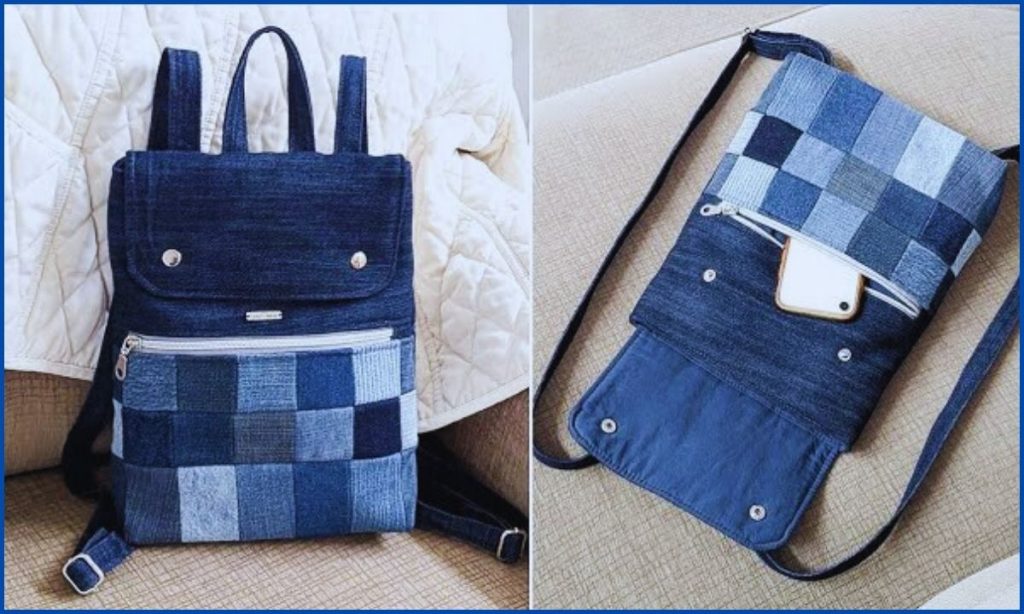
Step 8: Attach Drawstring Casing/Facing to Main Bag Body
- Turn your exterior backpack body right side out.
- Insert the drawstring casing/facing tube into the top opening of the exterior backpack body, aligning the raw edges of the casing with the raw top edge of the backpack body. Make sure the denim side of the casing is facing the denim exterior of the bag.
- Align the side seams of the casing with the side seams of the backpack body.
- Clip all the way around the top.
- Stitch around the entire top edge of the bag, attaching the casing, using a 1/2-inch (1.27 cm) seam allowance.
- Press the casing up and away from the main bag body. Topstitch around the top of the main backpack body, about 1/8 inch (0.3 cm) from the seam you just made, to help the casing lay flat.
Step 9: Prepare and Attach Flap
- Place the Exterior Flap Piece and Lining Flap Piece right sides together.
- If desired, round the bottom corners of the flap using a small plate or template.
- Stitch around the curved (or bottom and side) edges of the flap, leaving the top straight edge open. Use a 1/2-inch (1.27 cm) seam allowance.
- Clip curves: If you rounded the corners, clip the seam allowance around the curves to help it lay flat when turned.
- Trim the seam allowance down to about 1/4 inch (0.6 cm) around the stitched edges.
- Turn the flap right side out through the top opening. Push out the corners/curves neatly and press very well.
- Topstitch around the stitched edges of the flap, about 1/8 inch (0.3 cm) from the edge.
- Optional Magnetic Snap: If adding a magnetic snap to the flap, install one half now onto the wrong side of the flap’s end, following the manufacturer’s instructions.
- Attach Flap to Backpack Back:
- Take your exterior backpack body. Find the center back (between the two main strap attachments).
- Position the raw edge of the flap (the unstitched top edge) onto the outside of the backpack’s back, centering it horizontally. The flap should hang downwards. Place its raw edge about 1/2 to 1 inch (1.27-2.5 cm) below the top edge of the drawstring casing.
- Stitch the flap raw edge to the backpack body within the 1/2-inch seam allowance. Stitch securely.
Step 10: Final Assembly (Bag-in-a-Bag Method)
- Ensure your exterior backpack body is right side out, with straps, casing, and flap attached.
- Ensure your lining bag body is wrong side out (and still has that turning opening at the bottom).
- Carefully insert the exterior backpack bodyinto the lining bag body.
- The right sides of both bags should now be facing each other.
- Align the side seams of the exterior bag with the side seams of the lining bag.
- Align the top raw edges of the drawstring casing (the lining side of the casing) with the top raw edge of the lining bag body. The straps and flap should be tucked inside.
- Clip very securely all the way around this top edge, matching up seams precisely.
- Stitch all the way around the entire top opening of the backpack, attaching the lining to the casing, using a 1/2-inch (1.27 cm) seam allowance. Go slowly and carefully, especially over the thick areas where straps and the flap are attached. Backstitch at the beginning and end.
- Trim Bulk: Carefully trim the seam allowance at the top down to about 1/4 inch (0.6 cm) to reduce bulk inside the top edge.
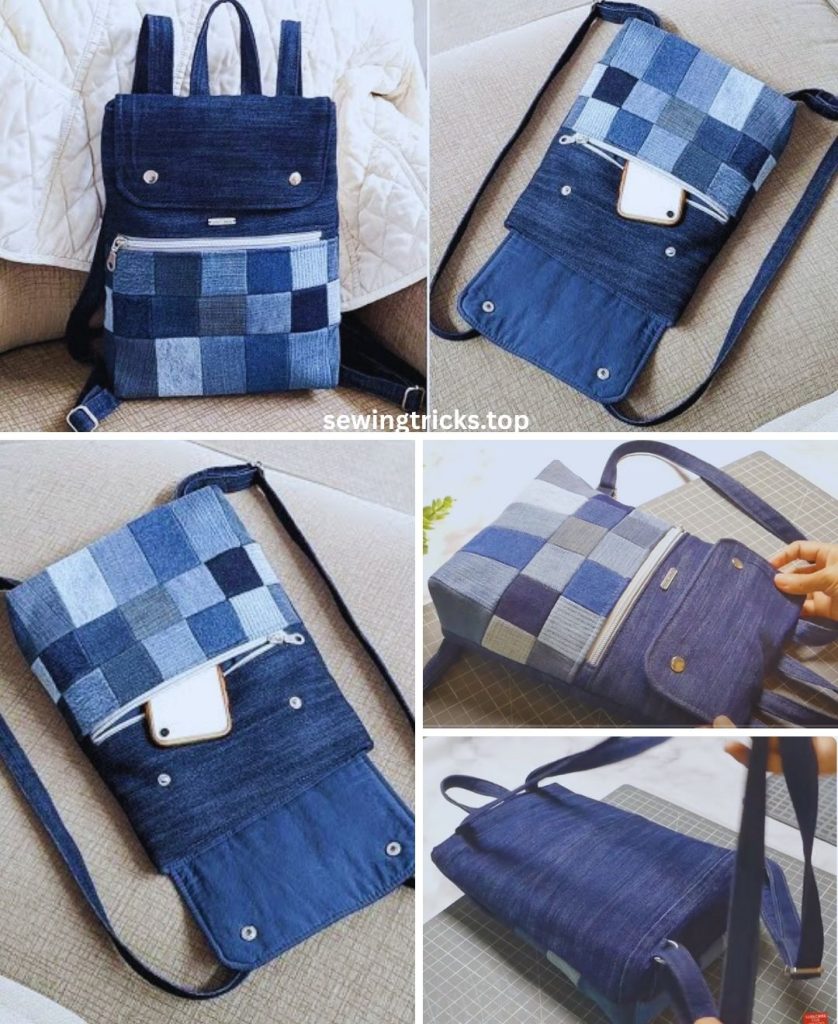
Step 11: Turn Right Side Out & Finish
- Remember that opening you left in the bottom seam of the lining (Step 6)? Reach through it.
- Slowly and carefully pull the entire backpack through this opening until it is completely right side out. Take your time, gently pushing out all the corners for a crisp, well-defined shape.
- Close the Lining Opening: Go to your ironing board. Press the raw edges of the opening in the bottom of the lining under by 1/2 inch (1.27 cm) so they meet neatly. Align these pressed edges and clip them together. Stitch this opening closed by machine (sewing very close to the folded edge for a neat finish) or by hand using an invisible ladder stitch for a truly seamless look.
- Now, gently push the lining down into the exterior denim backpack.
- Final Press & Topstitch: Carefully press the entire top edge of the backpack, especially around the drawstring casing, to ensure the fabric lays flat and the shape is crisp.
- For a super polished and durable finish, topstitch all around the entire top opening of the drawstring casing, about 1/8 inch (0.3 cm) from the edge. This helps the casing stand up and gives a professional look.
Step 12: Add Drawstring & Adjuster Hardware
- Create Drawstring Channels: On the drawstring casing/facing you sewed at the top, make two buttonholes (or small slits reinforced with fray-check) on the front of the bag, about 1 inch (2.5 cm) down from the topstitched edge, spaced about 1 inch (2.5 cm) apart horizontally. Ensure they go through both layers of the casing.
- Using a safety pin or bodkin, thread your drawstring cord through the casing, starting from one buttonhole, going all the way around, and coming out the other buttonhole. Adjust the ends to be even.
- Attach Strap Tabs (to bottom of backpack):
- Find the bottom corners of your exterior backpack.
- Position the raw ends of each strap tab (with rectangular rings) onto the bottom corner of the backpack, aligning the raw edge of the tab with the bottom raw edge of the backpack’s corner. The ring should face upward.
- Stitch the tab ends in place using an X-box stitch for extreme durability. Stitch within the 1/2-inch seam allowance.
- Attach Slider Buckles & Finish Straps:
- Take one prepared strap. Thread one end of the strap up through the bottom bar of a slider buckle, then down through the top bar of the slider buckle, creating a loop.
- Take the other end of that same strap. Thread it up through the rectangular ring at the bottom corner of the backpack (the ring attached to your strap tab).
- Now, thread this end of the strap back through the slider buckle, going up through the top bar and then down through the bottom bar, so it mirrors the first end. This creates the adjustable strap.
- Adjust the length of the strap. Once happy, you can stitch the very end of the strap to itself for a neat finish (or just leave it with a clean cut if the denim doesn’t fray excessively).
- Repeat for the second strap.
Your unique, upcycled Denim Backpack with a Patchwork Pocket is now complete! You’ve transformed old jeans into a sturdy, stylish, and highly personalized accessory that’s ready for adventure. Enjoy carrying your sustainable creation with pride!
What will be the first adventure you take your new denim backpack on?

